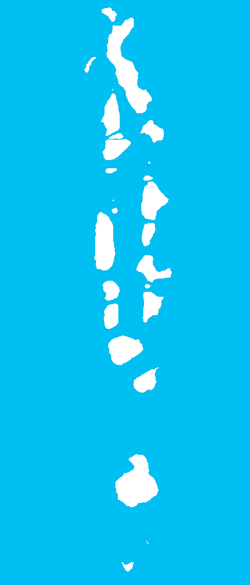Noomaraa (Shaviyani Atoll)
| Noomaraa | |
|---|---|
| Inhabited island | |
 Noomaraa Location in Maldives | |
| Coordinates: 06°26′01″N 73°04′02″E / 6.43361°N 73.06722°ECoordinates: 06°26′01″N 73°04′02″E / 6.43361°N 73.06722°E | |
| Country | Maldives |
| Geographic atoll | Miladhummadulhu Atoll |
| Administrative atoll | Shaviyani Atoll |
| Distance to Malé | 255 km (158 mi) |
| Dimensions | |
| • Length | 0.900 km (0.559 mi) |
| • Width | 0.480 km (0.298 mi) |
| Population (April 2012) | |
| • Total | 426 (as at 30 April 2,012) |
| Time zone | MST (UTC+05:00) |
Noomaraa (Dhivehi: ނޫމަރާ) is one of the inhabited islands of the Shaviyani Atoll administrative division, and geographically part of the North Miladhummadulhu Atoll in the Maldives.
It is located at the eastern tip of Shaviyani Atoll, 40 kilometres (25 mi) from the atoll's capital of Funadhoo and 250 kilometres (160 mi) from Malé. It is the least popululous island in the atoll. The Island code is C2. The area of Noomaraa is 41.3 hectares (102 acres). The length of the island is 900 metres (3,000 ft), and the width is 480 metres (1,570 ft).
Noomaraa is a typical island in Maldives. The first settlers of the island were a mystery to historians. It is believed that they are early Maldivian settlers dating back to 5th century BC with the Aryan immigrants coming from neighboring countries India and Sri Lanka. The island had maintained its uniqueness like that of many other islands in the Maldives; its culture, traditions, language and religion had been as of any other island in Maldives.
In Maldivian History, little has been written about Noomaraa. One of the available books was written by Maldives prominent historian Mr.Mohamed Ibrahim Luthufy in his famous history book "Dhivehi Raajjeyge Geographyge Vanavaru" (The Geographical Atlas of Maldives), in which he mentioned about the physical of the people of Noomaraa.
Population
According to the Secretariat of Noomaraa Council, the population of Noomaraa in 2012 was 426 people: 220 males and 206 females.
Economy
Fishing is the backbone of the economy of Noomaraa, with most fishing done by pole and line. The government-owned Maldives Industrial Fisheries Company also operates in the region. Fish sought include tuna of the "Latti" and "Raagondi" kinds. These tuna are boiled and dried in the sun, then sold to buyers in Male. Locally caught fish are also used to make rihaakuru, a traditional fish soup. During the past years, fish catch has increased rapidly.
Education
In 1986, a school called "Noomaraa Makthab" opened on the island. In 1991, it moved to new premises and changed its name to "Noomaraa School". In 2005, it became a government school. In that year, secondary education began, with only business streams. The school had an enrollment of 95 in 2012.
The island also has a preschool, which is managed by the Association for Noomaraa Development (AND). It has an enrollment of 35 students.
Environment
Extensive soil erosion has occurred on the northeast and northwest sides of Noomaraa.
Harbor
An area of 45,000 square feet (4,200 m2) in the island's harbor was dredged in 2012. The harbor is not entirely sheltered from rough weather: in windy conditions, fishermen have difficulty using it, and must stay awake nights safeguarding their boats.
Noomaraa In Statistics
Area: 41.3 hectares
Island Code: C2
Length: 900m
Width: 480m
Location 73°04' 02 E 6°26'01N
Distance from Male: 255 km
Population: 426
Male population: 220
Female population: 206
Economic Activities: fishing, Carpenter,
Shops (Private): 05
Fast Foods/Tea Shops: 02
Pharmacy: 01
Island School: Govt. Owned 1
Highest Grade 10
Preschool: Private Owned 1
Health Center: Govt 1
Nurses: 03
Doctors: 01
Mid Wives: 1
Number of Boundary Marked House Plots: 110
Number of Houses Boundary NOT Marked: 20
Fully Built Households: 74
Household NOT Fully Built: 36
Mosques (Ladies): 01
Mosques (Gents): 01
Bicycle: 100 Pvt (estimated)
Mechanised Dhoni 06
Sathari Dhoni: 02
Vadhu Dhoni : 16
Bokkuraa: 06
Rain Water Tanks: 74
Number of Houses with Toilets: 74